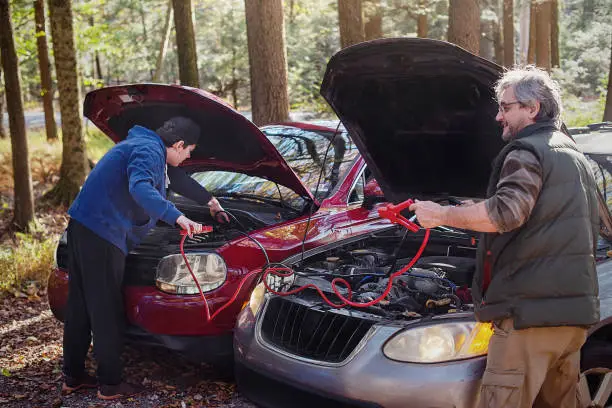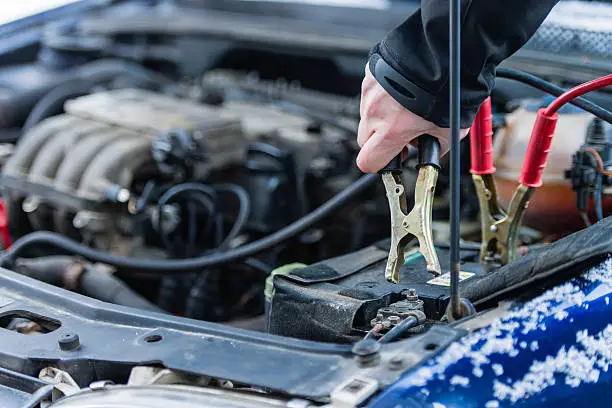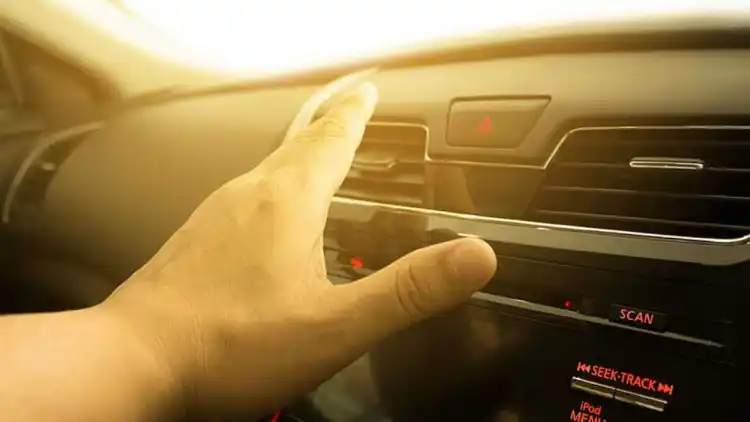Is your car refusing to start? Don't let a dead battery leave you stranded. This guide provides easy steps to safely jump start your car and get back on the road.
How to Jump Start a Car:Your Simple Step-by-Step Guide
Dealing with a car that won't start can be frustrating, but jump starting is a common fix for a dead battery. This guide will walk you through each step, making sure you can safely handle this common car trouble. Many vehicle owners will face this at some point. Knowing how to jump start your car can save you time and the cost of roadside assistance.
1. Safety First:Preparing for the Jump Start
Before you even think about connecting jumper cables, making sure everyone is safe is the most important thing. Take a moment to check your surroundings and your car's condition.
Find a Safe Spot: Always pick a flat, safe place away from busy roads. Make sure both cars are parked on level ground.
Turn Everything Off: Switch off both car engines. Take the keys out. Make sure all lights, radios, and air conditioners are off in both vehicles to prevent any unexpected power surges.
Stay Away from Sparks: Keep any open flames or sparks far away from the battery area. Batteries can release gases that are flammable.
Check the Battery: Look closely at the dead battery. If you see any cracks, leaks, or signs of damage, do not try to jump start it. Call for professional automotive assistance instead.
Wear Safety Gear: It's smart to wear gloves and eye protection. This will protect you from battery acid or sparks.
2. What You'll Need for a Successful Jump Start
Gathering the right tools before you begin will make the process smoother and safer. You don't need much, but these items are crucial.
Jumper Cables: These are essential. Look for heavy-duty cables. They are thicker and can carry more power, making the jump start easier and safer. Make sure the cables are not damaged or frayed.
A Booster Vehicle: You will need another car or truck with a good, working battery. This “booster vehicle” will give power to your dead battery. Make sure the booster car's battery is strong enough.
Safety Gear: Again, gloves and eye protection are highly recommended.
3. Connect the Jumper Cables Carefully
This part needs your full attention. Connecting the cables correctly is key to a safe and successful engine start. Follow these steps exactly to avoid sparks or harm to your vehicle battery or the booster car's battery.
Position the Cars: Drive the booster vehicle close to the car with the dead battery. You can park them nose-to-nose or side-by-side. Just make sure the cars are not touching each other at all. This prevents a short circuit.
Identify Terminals: Look for the positive (+) and negative (-) terminals on both batteries. The positive terminal is usually larger and marked with a plus sign, often covered with a red cap. The negative terminal is marked with a minus sign, often with a black cap or uncovered.
Red Cable to Positive (+) (Dead Car First): Take one red clamp of the jumper cables. Connect it firmly to the positive terminal (+) of your car's dead battery.
Red Cable to Positive (+) (Booster Car): Take the other red clamp. Connect it firmly to the positive terminal (+) of the booster vehicle's good battery.
Black Cable to Negative (-) (Booster Car): Now, take one black clamp of the jumper cables. Connect it firmly to the negative terminal (-) of the booster vehicle's good battery.
Black Cable to Metal Ground (Dead Car): Take the other black clamp. Do not connect it to the negative terminal of the dead battery. Instead, find an unpainted metal part of your car's engine block or chassis. This creates a ground connection and helps prevent sparks near the battery itself.
4. Starting the Engines After Connection
Once the cables are connected, you are ready to try starting your car. This process involves a bit of patience.
Start the Booster Vehicle: Turn on the engine of the booster car. Let it run for about 2 to 5 minutes. This allows its alternator to generate power and send a charge to your dead battery.
Try to Start the Dead Car: After a few minutes, try to start your car. Turn the key or push the start button.
If it starts: Great! Let both vehicles run for another 5 to 10 minutes, idling. This helps your battery get a bit more charge.
If it struggles or doesn't start: Turn off your car's engine. Let the booster car run for a few more minutes (maybe 5-10 more). Then try to start your car again. Do not keep cranking the engine for a long time, as this can wear down the booster car's battery.
5. Disconnecting the Cables Safely
Once your car is running, carefully remove the jumper cables in the reverse order of how you connected them. This is very important to avoid short circuits and sparks.
Remove Black from Ground: Take off the black clamp from the unpainted metal part on your car first.
Remove Black from Booster: Take off the black clamp from the negative terminal (-) of the booster vehicle's battery.
Remove Red from Booster: Take off the red clamp from the positive terminal (+) of the booster vehicle's battery.
Remove Red from Your Car: Finally, take off the red clamp from the positive terminal (+) of your car's battery.
Make sure the clamps do not touch each other or any metal parts of the cars while you are removing them. Coil the cables neatly for next time.
What to Do After Jump Starting Your Car
Getting your car to start again is just the first step. You need to make sure your battery gets properly charged and check for any deeper issues.
Go for a Drive: After your car starts, drive it for at least 20 to 30 minutes. This gives your alternator time to recharge the vehicle battery. Aim for highway speeds if possible, as this charges the battery more effectively than idling.
Get Your Battery Checked: If your car's battery dies again soon after a jump start, it likely means the battery is old or faulty. Visit a local garage or a specialized car batteries service center. They can test your battery life and your charging system (alternator). A new car battery might cost you anywhere from 300 to 700 AED/SAR, depending on the type and brand.
Practice Good Car Care: To prevent future dead batteries, follow these simple car maintenance tips:
Drive regularly, especially for longer trips. Short trips don't always give the battery enough time to fully recharge.
Turn off all lights, radio, and air conditioning when you turn off your engine.
Avoid leaving your car's lights or accessories on when the engine is off for long periods.
Consider a battery charger if your car sits unused for long periods.
Troubleshooting Common Jump Start Issues
Sometimes, even if you follow all the steps, things don't go as planned. Here are some common problems and what to do.
Car Still Won't Start:
Check Connections: Make sure all four cable clamps are connected strongly to the correct terminals. A loose connection is a common reason for failure.
Let It Charge Longer: Give the dead battery more time to charge from the booster vehicle. Run the booster car for 10-15 minutes before trying again.
Completely Dead Battery: Your battery might be too old or too damaged to hold a charge at all. In this case, jump starting won't work, and you'll need a new battery or roadside assistance.
Other Issues: The problem might not be the battery. It could be your starter motor, alternator, or fuel system. If jump starting doesn't work, it's time to call a professional for automotive assistance.
Clicking Noises When Trying to Start: This often points to a very weak battery or poor connections. Re-check all your cable connections. Make sure they are tight and clean.
Repeated Dead Batteries: If your car battery keeps dying, even after a successful jump start, it's a clear sign you need a replacement. Get a battery health check from a trusted garage. This is crucial for overall car health and preventing unexpected car trouble.
Jump Start FAQ:Your Questions Answered
Q:Can I jump start a car by myself?
A:Yes, you can. However, you will still need another vehicle with a healthy battery. While you can connect the cables alone, it's always safer and easier to have another person help you, especially for placing the vehicles and watching the connections.
Q:How long should I drive after a jump start to charge the battery?
A:You should drive for at least 20 to 30 minutes, keeping your engine RPMs relatively consistent. This gives your car's alternator enough time to put a good charge back into the battery. For best results, avoid short trips right after and aim for a longer drive.
Q:What if jump starting causes damage to my car?
A:If you follow the safety steps and connection instructions carefully, the risks are very low. Modern cars have protective systems. However, connecting cables improperly can cause major electrical damage (like blowing fuses or harming sensitive electronics). Always read your car's owner manual for specific advice, especially for newer car models. If you are unsure, it's best to call for expert help.
Q:Why didn't jump starting work for my car?
A:There are a few reasons why a jump start might fail. Your battery might be completely dead, meaning it cannot hold any charge. The problem could also be something else, like a faulty starter motor, a bad alternator (which recharges the battery while you drive), or even issues with your car's ignition system. If jump starting doesn't help, it's time to get a professional diagnosis.
Q:Can older/newer cars be jump started safely?
A:Yes, most cars, both older and newer, can be jump started. However, always check your car's owner manual, especially for very new or luxury models. Some newer cars have specific jump start points or might require different procedures to protect their advanced electronic systems. Following the manufacturer's guidelines is key to preventing any car trouble.
Read More:
JETOUR T2:What Company Makes This Adventure Pickup?
How Much is the Jetour T2 in China? Your Complete Buying Guide












